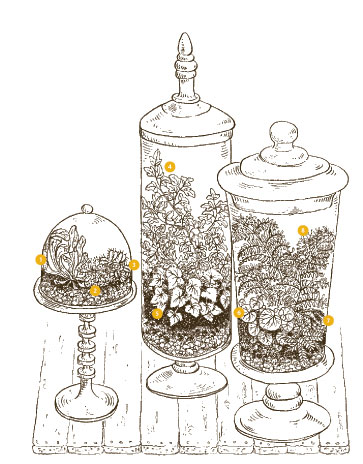Terrariums to the Rescue
As summer slowly sinks into the horizon, it’s time to bid a fond farewell to the garden, gather your tools, and go indoors. What better time to start a terrarium? Terrariums bring nature by your side. Whether you’re stuck in an office cubicle or need a little nature in your kitchen, bathroom, or wherever—terrariums add beauty and make indoor gardening easy. Basically, a successful terrarium is on autopilot—plants only require water once every few weeks or less.
Plants take on a new dimension when displayed within glass. For a setting, just find a clear container that you find appealing. It could be an apothecary jar, fishbowl, fruit compote, hurricane lantern, or anything else that speaks to you. Containers with lids make the most efficient terrariums—they rarely require watering. But open containers are also apropos; they just need to be watered more frequently.
Planting a terrarium is a cinch. Start by putting in an inch or two of 3/8-inch grade pebbles mixed with horticultural charcoal pieces as a filter and drainage base, then add a layer of potting soil. Select plants that prefer indirect light and high humidity and that will remain miniature. Three plants of varied colors and textures arranged in a triangular pattern work well in your average apothecary jar. Move the plants around to see the effect of various arrangements before you set them. Seedpods, lichen-covered twigs, stunning stones, and miscellaneous other bits of nature can complete the picture.
Once you are happy with your arrangement, firm the plants in the soil, tuck in the decorative elements, water lightly, and close the jar. Place your terrarium in indirect light, and if it’s lidded, ventilate it every two to three weeks for about an hour. Trim the plants if they begin to overstep their bounds. Check for condensation after putting the cover back on—water only when none appears on the glass. And enjoy! This could be your survival kit for all those times when you can’t escape outdoors.

Carnivorous Cloche
No need to hunt down an antique cloche for your terrarium—look for a glass cake stand. If the stand has a slight lip along its edge, planting will be easier. Carnivorous plants love the moist culture of terrariums. If you want them to “hunt” for food, just open the lid.
- Dionaea muscipula (Venus flytrap)
- Drosera species (sundew species)
- Sarracenia species (pitcher plant species)
Vertical Jar
For tall containers, select a plant to fill the height. In this confined space, a miniature ivy will grow gracefully and curvaceously upward without requiring support. The begonia crouches below, covering the ground with its dark, rounded foliage.- Hedera helix ‘Oak Leaf’ (miniature ivy cultivar)
- Begonia ‘Bethlehem Star’ (rhizomatous begonia cultivar)
Apothecary Jar
An easy-to-find container featuring no-fail plants for beginners. The strawberry begonia has handsome foliar markings and sends out interesting runners; the bear’s foot fern sprouts its fronds from furry legs; and the golden spike moss brightens up the scene.
- Saxifraga stolonifera (strawberry begonia)
- Selaginella kraussiana ‘Aurea’ (spike moss cultivar)
- Humata tyermannii (bears foot fern)


